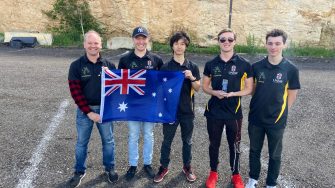UNSW Aussienauts land second place in Over the Dusty Moon challenge
With the lightest and most energy-efficient system, UNSW surpassed teams from the United States and Germany.
With the lightest and most energy-efficient system, UNSW surpassed teams from the United States and Germany.

A year after placing third in the inaugural Over the Dusty Moon challenge, the UNSW Aussienauts are celebrating second place in the prestigious Over the Dusty Moon challenge. The event, held in Colorado, USA, took place from 31st May to 1st June 2023. The Aussienauts were up against four other student teams hailing from United States, Germany, Poland and a mixed European team.
The goal of the competition was to demonstrate the systems they designed and built for moving lunar dirt, or regolith, around the Moon’s surface. Judging focused on the amount of regolith simulant transported, system mass, energy consumed, dust tolerance and generation, autonomy and overall performance.
Each team was tasked with building a prototype capable of efficiently transporting lunar regolith between a hopper and a molten regolith electrolysis (MRE) plant, five meters across and three meters up.
The UNSW team’s submission was an Autonomous Slat Conveyance System (ASCS), which was the lightest system in the competition (27 kg) and used the least amount of power (22W/hr). The system was comprised of a top axle with a motor attached to it, and a bottom axle. Slats were wrapped around both axles, creating a loop resembling a conveyor belt. Due to the continuous depositing, the team achieved a delivery rate of 96kg/hr, which would have been the fastest in the competition.
“The competition started out very well, the ASCS was successfully moving the regolith and separating the rocks. But then the butterfly valve of the hopper jammed open and could not be closed. This caused a massive issue as the motor became overloaded, causing it to break down,” says Justin Fang, second-year Aerospace Engineering student.
“Every competing team had a catastrophic failure during their allocation time. But it was how the teams reacted to these problems that made them successful. From the past two competitions, I have learnt that not everything will go right, and you need to be ready to expect the unexpected,” says Nick Barnett, PhD candidate in Space Mining at UNSW, and supervisor of the team.
“Sufficient testing prior to the competition is very important, to ensure you understand the system and can adapt when things do go wrong on the competition day,” he says.
The team continued to work through the challenges and managed to successfully deliver 16 kg of regolith within the one hour given.
The Aussienauts competing during the Over the Dusty Moon 2023 challenge
Following two days of intense competition and rigorous evaluation by a panel of judges, which included technologists from Lockheed Martin Space division, the UNSW team secured second place. Team AGH from Poland came in first place.
“I am very proud of the result and proud of the whole team for the work we put into this project. I feel that the result is a good representation of the efforts and passion of all team members,” says Finn Prince, fourth-year Mining Engineering student.
“This is truly an amazing result and great to see improvement from last year’s competition. The team learnt from previous mistakes and made sure that these were not repeated,” says Nick Barnett.
“Beyond the competition, it was great to see the team being there for our fellow competitors if they needed any help prior or while competing. Many non-competitors remembered this trait from the Aussienauts in 2022, a testament to the positive impact the team has had on the competition,” he says.
The success of the UNSW team provides a platform for further collaboration within the global space and mining industries. The team has been invited for further discussions by the Lockheed judging panel, who saw potential with the design for lunar operations.
“The success puts Australia and UNSW on the map within the space resources sector. We have made plenty of new connections with people all around the globe, across many different universities and companies, and these connections better equip us to push forward the space mining innovations,” says Finn Prince.
“It will allow a lot more opportunities for both UNSW and Australia to be more involved in the space and mining industry. Especially the space industry as it is still a developing industry in Australia,” says Justin Fang.
“The success of the team also shows that there are opportunities available to succeed on an international scale in the space sector. I hope that we can inspire and encourage more people to consider employment opportunities in the space sector. Increased visibility and success of Australians in the sector will hopefully lead to further commercial investment into Australia, generating further growth,” says Nick Barnett.
The Aussienauts (Peter Johnson, Duncan Slater, Finn Prince, Justin Fang and Nick Barnett) meeting the President of the Colorado School of Mines, Professor Paul Johnson.
The rest of the year, the team will be performing pioneering experiments on lunar regolith which will have real-world applications for missions like NASA’s Artemis program. They have also already started brainstorming improvements and new ideas for next year’s Over the Dusty Moon challenge submission. The team is planning to develop the design of the system further, making it more robust and improving on its weight and efficiency.
“We are excited to compete again next year with a replica of this year's design, but with refinements in multiple areas,” says Justin Fang.
The team’s success in the Over the Dusty Moon challenge would not have been possible without the help of their generous sponsors: Fleet Space Technologies, Maptek, Rocscience, Redwood Technology (RedwoodTEQ), Office of the NSW Chief Scientist & Engineer and the School of UNSW Minerals and Energy Resources Engineering.